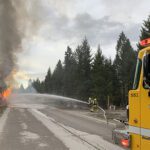Home »

Interior RDs moving 9-1-1 service to E-Comm
This fall, 9-1-1 call answer services for nine interior regional districts, including the Regional District of East Kootenay (RDEK) will move to a new service provider.
Starting November 18, 9-1-1 calls placed from the Regional District of Central Okanagan, North Okanagan, Okanagan-Similkameen, Thompson-Nicola, Columbia-Shuswap, Squamish-Lillooet (North), Central Kootenay, East Kootenay and Kootenay-Boundary regional districts will be answered through E-Comm, the emergency communication centre located in the Lower Mainland.
The Regional District of Central Okanagan (RDCO) provides initial 9-1-1 call response services to the nine regional districts throughout the B.C. Interior.
The RDCO currently has a Memorandum of Understanding with the Royal Canadian Mounted Police for initial Public Safety Answering Point (PSAP) service, which is provided out of the Southeast District Operational Communications Centre (OCC) in Kelowna. That is where all 9-1-1 calls placed within the nine regional districts are answered by a Telecommunications Operator who determines the nature of the emergency call and quickly transfers the caller to the appropriate first responder agency (Police, Fire or BC Ambulance).
Regional District of Central Okanagan Chair Robert Hobson says, “For almost two years, we have been exploring various options for 9-1-1 call answer services on behalf of all nine interior regional districts. In 2012 we were advised by the RCMP that we would be facing significant increases for provision of 9-1-1 services. After an extensive review and negotiations, we’ve recently signed a five year contract with E-Comm in Vancouver. The transition from the RCMP OCC to E-Comm will take place November 18.”
Hobson adds, “By contracting our 9-1-1 service to E-Comm, over the five year agreement the regional districts will see a 25% reduction in overall program operating costs. That translates into total savings of more than $2.1-million for the program, proportionately shared by the regional district partners.
“Public safety remains our top priority” says Hobson. “E-Comm’s outstanding track record of high quality and reliable 9-1-1 answering services, means all residents in the affected regional districts can be assured there will be professionally handled, quick response to their initial emergency calls.”
In addition, by having E-Comm provide initial emergency call handling service, the regional districts believe they’ll be in a better position to take advantage of Next Generation 9-1-1 technology.
Until the change this fall to E-Comm, 9-1-1 PSAP calls will continue to be answered by staff in the Southeast District Operational Communications Centre. Within the service area of the nine regional districts during 2013, a total of 226,796 9-1-1 calls were received and answered by the OCC based in Kelowna.
“We are pleased to partner with the Regional District of Central Okanagan and are committed to ensuring residents of all nine regional districts continue to receive high-quality, responsive 9-1-1 public safety answer point service 24-hours a day,” says E-Comm President & CEO David Guscott. “E-Comm is focused on helping to create safer communities in B.C. through excellence in public-safety communication, and we believe that an integrated approach is a key element in achieving that vision.”
E-Comm’s integrated multi-jurisdictional call taking and dispatch centre provides economies of scale by providing 9-1-1 service for Metro Vancouver, the Sunshine Coast Regional District, Whistler, Squamish, the Squamish-Lillooet Regional District (South). It recently agreed to begin providing 9-1-1 service this fall to the North Island 9-1-1 Corporation which is comprised of six regional districts in addition to the regional districts of Fraser Fort-George, Cariboo, Bulkley-Nechako and much of the Kitimat-Stikine RD.
E-Comm utilizes top tier technology in a Vancouver building that is secure and purposely designed and built to resist a major earthquake (7+) and be self-sufficient for 72 hours. It has a number of backup provisions to ensure the continuity of 9-1-1 call answer services for a variety of scenarios. In 2013, E-Comm received 861,694 emergency calls, answering 98% of them in five seconds or less.
The National Emergency Number Association (NENA) standard is to answer 90% of all calls within 10 seconds.
Would it be faster to have 9-1-1 calls answered locally?
E-Comm has some of the toughest call-answer targets in North America and consistently meets or beats those targets on an annual basis – year after year. In 2013, E-Comm received 861,694 emergency calls, answering 98% of them in five seconds or less. This exceeds the National Emergency Number Association (NENA) standard of answering 90% of all calls within ten seconds.
If a resident calls 9-1-1 for police, how will a 9-1-1 operator in Vancouver know where to send help?
9-1-1 calls that are received by an E-Comm operator will be transferred to the same dispatch centres that are currently in use. For example, if someone in Trail, Salmon Arm or Blue River calls 9-1-1 and requests police assistance, the E-Comm operator would transfer the call to the RCMP Dispatch Centre based in Kelowna. A transition plan is being developed and will take into account all of the many technical and operational needs required to ensure this service remains seamless for all residents of the affected regional districts.
Where are the dispatch centres for ambulance and fire calls from our area?
Ambulance calls are transferred to the BC Ambulance dispatch centre in Kamloops where they will dispatch local ambulance units. Fire calls are transferred to the appropriate local fire dispatch centre. For example, in the Central and Okanagan-Similkameen Regional Districts, fire calls are transferred to the Regional Fire Dispatch Centre located at the main fire hall Number 1 on Enterprise Way in Kelowna.
Why switch 9-1-1 call answer service providers?
The regional district’s emergency services will be strengthened by having its 9-1-1 operations located in a secure, purpose-built facility that has many built-in redundancies and other special features such as 24-7 call centre management oversight to support staff, a back-up site and access to more staffing resources to manage sudden influxes of 9-1-1 calls, as there is a larger workforce from which to draw.
E-Comm has invested in the latest technologies to provide proven reliable and effective call answer services. It provides 9-1-1 call answer services to large and small communities over much of B..C and as such, operational expenses are shared amongst a larger group which provides cost savings for the regional district. To find out more information please visit the E-Comm website: www.ecomm911.ca.
What will happen to existing 9-1-1 PSAP Telecommunications Operators?
The Regional District of Central Okanagan has 12 full time telecommunications operator positions. Many of the employees hired in these positions have already transitioned to other employment with the Regional District or with the RCMP as Civilian Member Telecommunications Operators. The remaining employees are considering their options.
How reliable are E-Comm’s 9-1-1 call answer services?
E-Comm has operated a 9-1-1 primary PSAP and a secondary PSAP for 15 years, managing more than 14-million 9-1-1 calls and has earned a reputation as a leading emergency communications centre in North America.
E-Comm uses a variety of technologies to support 9-1-1 call answering and worked very closely with TELUS over the past 15 years to optimize the 9-1-1 call handling system to ensure that its emergency dispatch centre provides 9-1-1 call answering with the highest levels of service and reliability. E-Comm maintains an ongoing maintenance and upgrade strategy for all critical systems to ensure they are all kept up-to-date.
Will switching to E-Comm save money for the regional district?
There are considerable cost savings by contracting with E-Comm. Considering the number of communities and local governments already serviced through E-Comm, there are economies of scale, which reduce our costs by about 25% over the next five years. Under the new model, 9-1-1 call answer services will be significantly reduced by more than $2.1-million over the next five years.
In addition, E-Comm has already invested in updated call answer technology. If we were to maintain call answer services locally, the nine participating regional districts would have to absorb the full cost of any technology or system upgrades and staffing additions.
Looking ahead to the latest technology, E-Comm is taking a leadership role in the development of a long-term vision of 9-1-1 through the development of the ‘Next Generation 9-1-1’ (NG911) system for BC.
Will switching to E-Comm for 9-1-1 service affect the 9-1-1 services to any of the nine participating regional districts?
No. The Regional District of Central Okanagan has provided 9-1-1 service since 1988. We have consulted extensively with our eight other partner regional districts about the change in call answer services and are pleased that we will continue to provide 9-1-1 call answer services through a contract with E-Comm. The switch to E-Comm will take place November 18th and provides significant savings that will be passed onto our partner regional districts.
Does a 9-1-1 caller have to do anything differently?
No. Any person with an emergency would dial 9-1-1 as usual. The change will be transparent to the caller.
What’s involved with switching call answer service providers?
The transition of 9-1-1 call answer service providers will require development and implementation of a detailed plan that will include the regional districts, the RCMP, TELUS and E-Comm. There are network configuration changes that will need to be designed, implemented and tested as well as the development, implementation and training of new processes and procedures at E-Comm. The testing of the network configurations, process and procedures will include calls from each of the municipalities as well as confirmation of the 9-1-1 call transfers to each of the existing downstream BC Ambulance, RCMP and Fire Dispatch Centres through the normal and back-up configurations.
Last year, E-Comm successfully integrated the 9-1-1 police call taking and dispatch services for the Burnaby RCMP and the New Westminster Police Department. This fall it will also begin providing 9-1-1 call answer services for the North Island 9-1-1 Corporation, comprised of six regional districts and the regional districts of Fraser Fort-George, Cariboo, Bulkley-Nechako and much of the Kitimat-Stikine RD.
RDEK







